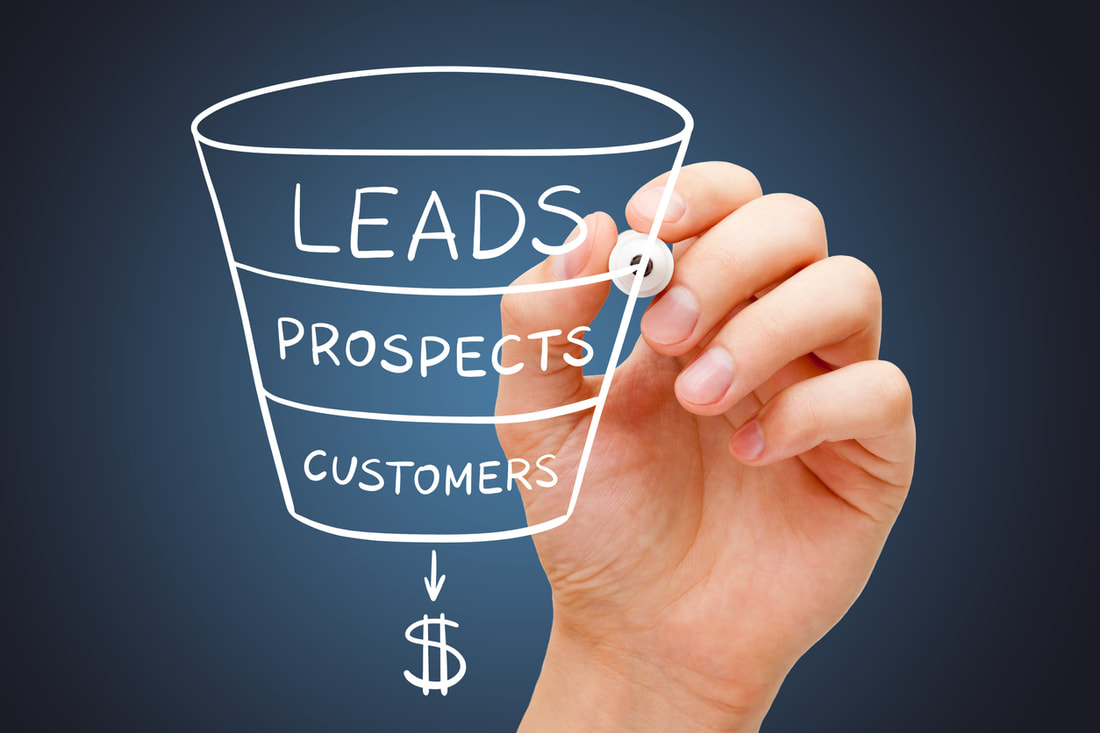|
Many sales reps and marketers truly believe in their products. They are convinced that the product is great, and they're also convinced that customers will love it. However, there's often a disconnect between the reasons they are so excited about the product and the reasons customers may be interested in it. That disconnect can lead to missed opportunities, lost sales, and a lot of head-scratching on the part of your team members. "Why aren't we selling more of this product?" they may wonder. "What are we missing?" In many cases, the root cause of the problem is a failure to use benefits-centered messaging when interacting with prospects and leads. The Difference Between Features and Benefits When we talk about "benefits-centered messaging," what are we actually referring to? Simply put, it's a type of storytelling that's relevant to and compelling for your audience. It's not focused on the what or the how of your product — rather, it articulates the why of it: why would your leads want to buy what you're offering? Why will it make their life easier, simpler, or better? Benefits-centered messaging is much different from features-centered messaging. For example, imagine a marketing message focused on the features of a new smartphone. Perhaps it discusses how advanced the camera is, or how many pixels will be in your photos. The emphasis is on the technical aspect of the product, the what and how. Now take that same scenario, and imagine a benefits-centered message for the smartphone camera. Maybe the message would be something like: "Capture your memories and relive them more clearly than ever before." The focus has shifted away from the technical specs, and onto why customers should be interested in the camera — in this case, because it will help them better remember precious moments for years to come. The Two Paths To Purchase At the core of every purchase decision is at least one of two powerful motivators: fear and desire. People either want to avoid pain or achieve a state of being better than the one they currently are in. All products and services are designed to help the buyer avoid the pain they fear or obtain what they desire. Therefore, the job of your sales and marketing teams is to tell a story about how your product will help customers meet one of those goals (or sometimes both). You could even replace the word "benefits" in the phrase benefits-centered messaging with "positive outcomes" — the meaning remains exactly the same. What's the point? Dumping a list of features onto your website or other forms of marketing content probably won't get you the best results. On the other hand, identifying what your customers truly want and need, and creating messaging that guides them to your solution, is what will help you get wins consistently. With that in mind, try looking at your product through the eyes of the customer by asking yourself questions like:
Remember, the same product may hold out different benefits for different people. So while it's important to know what a product does, it's just as important to understand what a product can do for the customer. How To Beef Up Your Benefits-Centered Messaging It's important for your company to have a solid, well-articulated identity. In other words, you need to answer the question: "What do we do?" Now, the challenge is to build on that foundation by answering the question: "What positive outcomes can our company help bring about?" In terms of interactions with your customers, there are two main ways to do just that: 1. Communicate Benefits With Your Marketing Copy A lot of company websites out there start almost every sentence on their home page with "we" or "our." For instance:
The problem with these statements is that, frankly, just about any competitor could say the same thing. Experience, commitment to customer service, hard work — these are simply the price of entry in most industries. They're not differentiators in any meaningful way. At the end of the day, people don't buy from your company because of your expertise or technical abilities; they buy from you because of the benefits you offer, and their trust that you'll deliver on those benefits. Therefore, your entire website (and any other marketing materials you publish) should speak to and serve the needs of your target audience. Don't brag about how fantastic your company is; rather, make it clear how you've made — and are making — your customers' lives better. 2. Center Your Conversations Around Positive Outcomes Using benefits-centered messaging is especially important when conversing with leads. Many sales reps fall into the trap of extolling the virtues of their product without seeking to understand what specific fear or desire is motivating the person across from them. On the other hand, asking questions and truly listening to the answers can help salespeople to steer the conversation in the right direction, and ultimately toward a purchase. Consider using the following questions (or variations on these questions) to better understand your prospects:
It's amazing how many sales reps don't ask these questions — and yet, getting the answers is often the key that will help you convince the customer of your solution's value to them! In summary: don't focus so much on product features. Instead, think like your customers, and focus on the benefits they're looking for. If your sales and marketing teams practice this approach, you're virtually guaranteed to see improved results from their efforts. Learn More A healthy relationship between sales and marketing is vital to an organization’s success. Dive deep into this effective strategy in a new book called Sales & Marketing Alignment. If you'd like more insights on how you can improve your sales leadership, contact us. Or sign up for our newsletter for more valuable resources.  Today's marketing teams require a multi-channel approach to carrying out both online and offline marketing campaigns. While utilizing multiple channels enables marketers to personalize a customer's sales journey throughout the sales funnel, there are some unique challenges when analyzing a particular marketing campaign and its ROI. One key metric to determine your marketing ROI is through attribution. If your company is not focusing on sales and lead attribution, here is why it should be at the forefront of your marketing campaign. What is Attribution? Attribution indicates how prospective customers enter your sales funnel. Likewise, it serves as a touchpoint of customer experiences throughout the buyer's journey. It specifies what door they came through, what channels and messages resonated with them the most, and what was the deciding factor that led to a purchase. A common flaw for many businesses is they fail to clearly understand attribution, leading to a lack of understanding of which sales tactics and initiatives are working best for their bottom line. Focusing on lead and sales attribution can help your business determine where it is getting the most ROI for your marketing dollars, and what acquisition channels are the most valuable. Why is Attribution Important? Attribution programs require marketers to aggregate consumer data across all levels of your marketing channels. The data is then normalized and properly weighed to give your business better insight into the customer's decision-making process. For instance, if a potential customer receives both an email ad and a display ad, but only clicks on the promotion from the email, it indicates to your marketing team the email was more effective at enticing interest for your good or service for that particular customer. Understanding attribution can improve your business' decision-making process. Attribution helps you determine which channels are better at generating new leads, or which channels are more effective at converting leads into finalized sales. If you find your promotional emails are generating more leads, then you can allocate more resources to your email campaign. To achieve efficacious attribution requires advanced marketing analytics that can take a large amount of data and convert it into personal-level insights, which you can then use to optimize your marketing campaigns. Benefits of Effective Attribution
Avoid the Pitfalls Despite the many benefits attribution can bring to your business, some common pitfalls can obscure the success of marketing campaigns. To ensure you are getting the most valuable insight from your data, these are the common mistakes marketers should avoid when using attribution models:
Attribution Models Single-touch Models First-touch attribution assumes a customer chose to convert after the first advertisement they came across. Therefore, it gives attribution to the first touchpoint, regardless of any additional messaging subsequently introduced. Last-touch attribution gives entire attribution credit to the last touchpoint the customer interacted with before finalizing the purchase. It does not take into account any prior engagements. Both single-touch models fail to account for the broader customer journey. Multi-touch models Multi-touch attribution models look at every touchpoint a customer engages with throughout the buyer's journey. Therefore, multi-touch models are more accurate at depicting the efficacy of your marketing efforts. These models are different by how they divide credit between touchpoints. These include:
How to Improve Your Sales Attribution Sales and lead attribution are crucial aspects for your business, and knowing how to accurately gauge your customer's journey is paramount. Want to learn more, but not sure where to start and need some expert advice, check out our website to view our informational webinars, or sign up for our weekly newsletter. Do you solution sell? Here's a quick tutorial to help you solution sell more effectively during the entire sales life cycle. In this whiteboard video, Karl Becker introduces a simple, proven construct called Trial Balloons - a construct to test the waters and move up the value-creation ladder in any sales conversation. When you use Trial Balloons you will sell more effectively and create more value.
You know that a strong value statement is crucial effective sales management, and ultimately for your company to thrive. It’s that power statement — those magic words — that tell your client that you understand their problem and have the perfect solution at the ready.
Though value statements are often brief, the process of getting to those precise, honed words can be anything but. So, here are some hacks and examples to help you write your own winning value statement. Questions to Answer with Your Team Before you put word one down on the page, you want to make sure you have these five questions answered with your team:
Putting it all Together: Examples + Templates
Now that you have all the elements, you want to put them together in a way that’s attractive, easy to process and memorable. Here are some hacks for doing just that.
Write one powerful sentence.
The most straightforward way to build your value statement is to connect your client and their challenge to your services and benefits in one, clear sentence. In Crossing the Chasm: Marketing and Selling High-Tech Products to Mainstream Customers, Geoff Moore suggests using the following template to do just that: Template
Examples
Compare your service to something your client already knows.If you can find a way to compare your service to another well-known product in another industry, you’ve found a shortcut to conveying your value proposition. By relying on your audience’s knowledge of the familiar product, you can quickly say a lot about what you offer.Template
Examples
Focus on who and how you help.Steven Blank’s suggestion for cutting through the noise is to frame your value proposition in a way people will easily understand. He suggests focusing on who and how you can help.Template
Examples
Nail your elevator pitch.Building off of Dave McClure’s How to Pitch a VC presentation, which encourages businesses to focus on short, simple, memorable keywords or phrases, use this simple template to define the elevator-pitch version of your value proposition.Template
Examples
Challenge yourself to be brief.Ernest Hemingway was once challenged to write an entire story using no more than six words. Since then, many writers have similarly tried to pack an entire story into as few words as possible. Can you convey the value you provide in six words or less?ExamplesWant more templates? Check out our Value Messaging Worksheet. Looking for more on how to grow faster? Check out 10 Sales Tactics CEAVCO Audio Visual Used to Generate $2 Million in New Revenue. Your value proposition is your company’s North Star. It guides you in every client-focused aspect of your business and provides direction in times of confusion. That’s a lot of weight for a few sentences. Your value proposition is important because it embodies what you provide your clients. Look at any successful company, and you'll find every one of them clearly articulates the value they offer. For example, Slack’s value proposition is “making working lives simpler, more pleasant, and more productive — for everyone.” Digit’s is “save money, without thinking about it.” This strategic message helps your clients find you and helps your team rally behind what you do. Without one you'll create the internal and external confusion that commonly results in lost sales. Here are four reasons why you might be avoiding writing a value proposition — and tips for working through those roadblocks. 1. You’re Only Focused on Leads Creating your value proposition may seem like a time-waster compared to the everyday quest of attracting clients, but it definitely isn’t. Operating without one can create the kind of inconsistent experience that may hurt your brand — and your growth. If you are unclear on the value you provide, you’re likely unclear on who you provide it to and how you create it. Without an understanding of these foundations — value, audience and offerings — your team is selling blind. You may be successful in the short-term in generating some sales, but you’ll be closing fewer deals than you could with alignment. Without clarity around these fundamentals, growth often plateaus. Everyday operations and closing deals today are both crucial to keeping the lights on. But if you want those lights to be on five or ten years down the road, make time for deep, strategic thinking today. 2. Your Leadership Team isn’t Aligned Does your leadership team see eye-to-eye about what you offer? Without this alignment, it’s difficult for leaders to guide organizations effectively. This lack of clarity can impact not only your team, but how clients perceive you. It’s easy to believe that you and your partners are aligned, even if you are not. You have an intimate understanding of your product, right? You’re experts! However, your value proposition is the articulation, not of what you sell, but of the need that your products or services fulfill. For example, you may be aligned on the fact that you are selling event services to small- to mid-sized businesses. But, your partner may see your primary value as “saving busy executives time and money by taking responsibilities off their plates." At the same time, you see your primary value as “bringing clients the new ideas that really engage audiences.” Neither answer is right or wrong, but misalignment can lead to inconsistent messaging and ultimately miscommunicating your real value. Both saving resources and creating engaging experiences are great value propositions for event services businesses. But, only one should be your primary focus, the goldstar message that you communicate to your team and to your customers. Take the time to really articulate — together — what you think the purpose of your company is in the eyes of your clients. If you find disagreement or differences of opinion within leadership, these are often opportunities for growth. 3. You’re Afraid of Getting it Wrong Nothing stifles curiosity and creativity quite like perfectionism. If you and your partners find yourselves continually revisiting and redrafting your value proposition but never finalizing it, you may be paralyzed by fear of getting it wrong. There’s no doubt that the value proposition is important. But, overemphasizing how crucial it is to the point that you are operating without one is counterproductive. Your value proposition will grow and change with your company over time and with the changing needs of your client base. Don’t languish without one. After some hard work, client research and open conversation, give one of your best drafts of your value proposition a try. 4. You're Resisting Growth and Change It’s even more important to sync with your team as your company grows. If you resist writing your value proposition, or reworking one that’s outdated, you need to take a good hard look at what’s changing, and how you’re handling it. Perhaps the real value of your offerings has incrementally changed with your audience. It’s easy to overlook this kind of gradual change — until you find your value proposition sounding increasingly stale or inaccurate. Periodically reevaluate what you’re providing your clients — and why. Take regular client polls that help you understand what challenges you help them meet. Check in with your sales team — not just on their numbers, but on questions and thoughts from leads and clients. Look for patterns and create messaging that reflects your current solutions and where you are headed in the future. This will not only help keep your value proposition on-point, but will help you stay on the pulse of your clients.
Not writing a value proposition plagues companies for some of the reasons outlined above. But every company needs one, including yours. It guides your sales efforts, helps express what you do for potential clients, and leads your company in the right direction.
Do you need help developing your company’s value messaging? Explore this worksheet and video with your team. One of the most powerful ways to gain clarity into your strengths and to grow faster is to define how you create value for your clients. Check out the video above as Karl Becker from The Carruthers Group describes the importance of aligning your sales organization around your defined value. ,
How would your sales team talk to a prospect about your brand? Would they all use the same words to describe it? When they dig into who you are and what you do, do they share a common language? Check out the video above as Karl Becker from The Carruthers Group describes a simple, but powerful exercise to find out if your sales team aligns around your brand value. When companies lack leads or have an empty sales funnel, it’s common for execs to start searching for the newest, hottest sales- and lead-focused solutions. But these are just Band-Aids, and they won’t help you achieve long-term success if the source of your trouble lies in the internal functioning and processes of your company. Generate more leads by looking within. Here’s a look at the three internal steps you need to take before you can make any solid movement forward. Determine Your Ideal Customer Does your team treat every lead the same? Think again. Before you can create a high-functioning sales organization, you need to know exactly who you sell to. Just as a regular gas engine doesn’t run on diesel, you can’t transform prospects into customers if you don’t sell what they need. You might have a single target audience — or you might have a couple. Take a look at everything your company offers. Then, identify the people who need exactly that. With a clear understanding of who your ideal customers are, you can move forward in a coordinated — and profitable — direction. Define What Your Company Does for Customers With your ideal audience in mind, it’s time to define your company’s value. Your value definition is like GPS. It gives your team a clear path to follow. Plus, it makes it easier for you to attract generate qualified leads and maintain their interest. Before you can increase leads, you and your team need to agree on what you do for customers. Sit down with your team, and identify the words or phrases that describe your company. It’s worth the effort to make sure your team is aligned around the value you provide. As you explore different opportunities, this infrastructure of what you do and who you do it for will help guide your path Clarify Your Brand Message Finally, once you know your value internally, you need to communicate that value externally. So, before you set out to generate more leads, make sure you’ve clarified your brand message. This means putting your value message into words that are meaningful to your prospects and customers. Value messaging looks like this: “We help _____ do _____ by providing _____.” For example: “We help manufacturers source hard to find materials through a web-based platform that uses search technologies to find and rate material providers that have immediate inventory.” Simple, yet extremely effective.
Consider your ideal audience, what you help them do and how you help them do it. Just as a map will point you in the right direction and a full gas tank will help you reach your destination, these three steps will help you fill your sales funnel with qualified leads, and then turn those qualified leads into customers. This is the foundation of a solid, high-performing sales engine.
Learn more about how we can help align your team with a Sales Engine Workshop or a Sales Engine Program. |
Meet Me
Archives
April 2024
Categories
All
|
|
We are headquartered in Colorado with domestic and international teammates and clients. Please use the contact form on this page to inquire about any of our books, podcasts appearances, speaking engagements and workshops, any of our offerings, or simply to connect.
|
© Improving Sales Performance. All Rights Reserved.






 RSS Feed
RSS Feed
